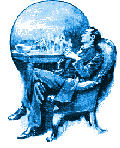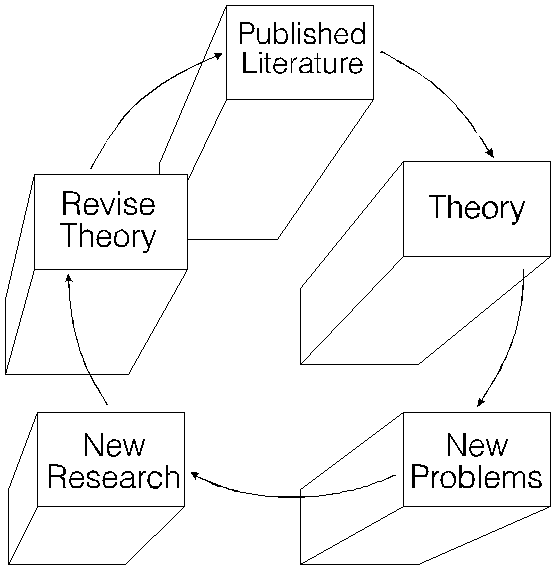
What is Deduction? - The Steps in the Process 
![]()
Research begins with a problem that needs an answer or a question that captures the imagination. Research is a systematic way of asking questions, gathering data, and drawing conclusions. When one sees a client with a medical problem, the process of diagnosis and treatment is the same process as research. The problem oriented medical record uses the same process as does research, e.g., data gathering, problem lists, treatment plan, SOAP notes, and disposition. The process of research is even reflected in SOAP notes, e.g., subjective and objective data gathering, assessment of problem, and progress in problem resolution.
The Research Process
The basic research process has seven steps. The steps are:
Every research study goes through these seven steps. Other researchers may define the process in fewer or more steps, but the process is universal.
Each research study is part of the larger process of theory building. Theory building is diagrammed in the figure below.

There is much new terminology to learn regarding the conduct of research. While many terms are in common use, there are unique terms used by some disciplines. This book has tried to focus on the process of research and to simplify what is a very complex area. In general the terminology used was taken from psychology, education and the health sciences. During subsequent courses you will likely encounter new names for concepts and processes introduced here. Please focus on the concepts of research and the terminology will take care of itself.
In Chapter One we begin our discussion of the research process with an overview. The subsequent chapters will expand on the details.
Scientific Reasoning
Sherlock Holmes said that the art of deduction was based on observation and not just seeing. We all see things, but we usually do not organize what we see into patterns and draw conclusions based on our observations. Sherlock Holmes could tell if a person were a physician by the bulge of a stethoscope in his hat, if he had gone to China by the coloring of a tattoo, or what he was thinking by the objects his attention was focused on. Dr. John Watson was always amazed at Holmes' deductions, but said "When I hear you give your reasons the thing always appears to me to be so ridiculously simple that I could easily do it myself, though at each successive instance of your reasoning I am baffled, until you explain your process. And yet I believe that my eyes are as good as yours" (Doyle, 1975, p.2).
Indeed we all have good eyes, in that we can gather information from our surroundings, but we may not be skilled at drawing conclusions from our observations. Actually scientific reasoning uses both induction and deduction as organization processes. Induction is the process of linking facts to consequences, e.g., the stove is hot and if I touch it I will be burned. Deduction is based on using theories and facts to predict future conditions, e.g. a liquid will turn to a gas if it is heated sufficiently, therefore water over a fire will turn to steam. The double movement of reflective thought, a term attributed to the American philosopher, psychologist, and educator John Dewey, refers to the cognitive processes of reasoning used in problem-solving. Whether in science or everyday life problem-solving involves the movement back and forth from the empirical world of observation to the abstract world of hypothesis and theory via deductive and inductive reasoning. Everyday, clinical, and scientific problem-solving do not differ in essence.
Table 1 - Cognitive Reasoning Process
FACT |
PREDICTION (HYPOTHESIS) |
| Lamp does not work. ---Ø | New bulb will cause lamp to come on. |
| Replace bulb and light still does not come on. | ×--- |
| Notice lamp cord is not plugged fully into wall socket. ---Ø | Pushing in plug will make light work. |
| Lamp comes on. | ×--- |
Here is an everyday example: Suppose when you go home tonight you flip the light switch at the front door and the lamp does not come on. You think "The bulb has probably burned out." Replacing the bulb you find that the lamp still does not work. You then note that the plug has worked loose and plug it in snugly. The light comes on.
This seemingly trivial example can be analyzed to reveal the double movement of reflective thought. A simplified diagram of the process is in Table 1. You begin with an observation: When the switch was flipped, the light did not work. Using inductive reasoning, you hypothesize that the bulb has burned out. You deduce from the hypothesis that if the bulb is replaced the lamp will work. The prediction is not confirmed as the lamp still does not work. You then observe that the lamp is not snugly plugged in. Hypothesizing that the lamp will work if snugly plugged in, you test your prediction by plugging in the lamp and confirm your prediction.
You will find that scientists rarely will state that they have "proven" a hypothesis or theory. Rather, they will speak of "supporting" or "not supporting" a theory. In the above example, did we prove that the first bulb was not burned out? It is possible that the bulb was burned out and the lamp unplugged. Albert Einstein said that scientific reasoning is simply a refinement of everyday thinking.
![]()